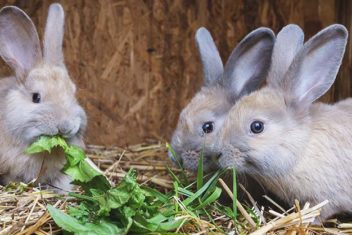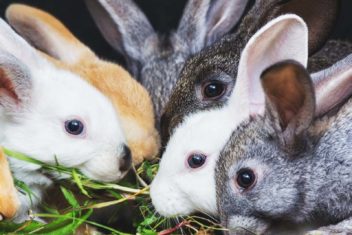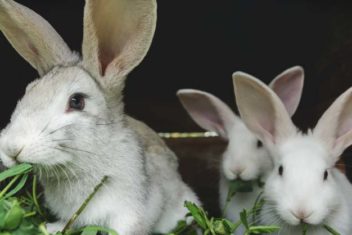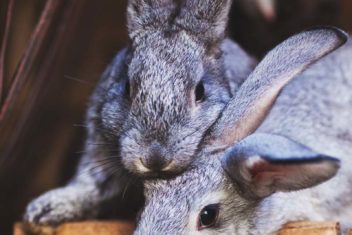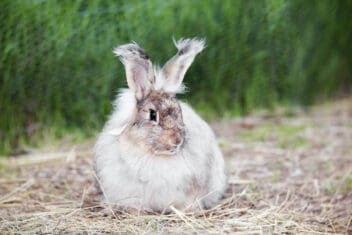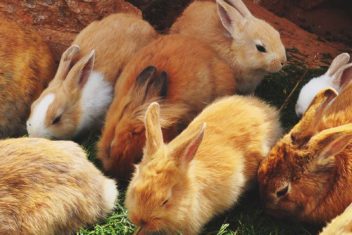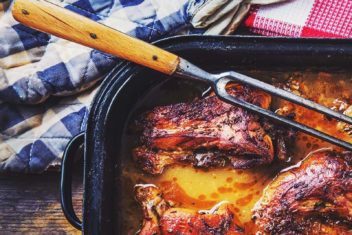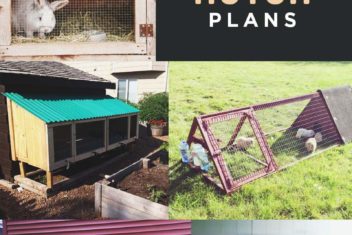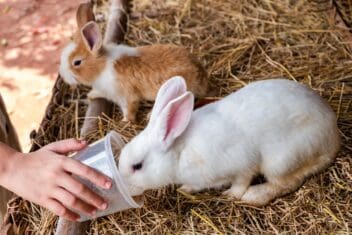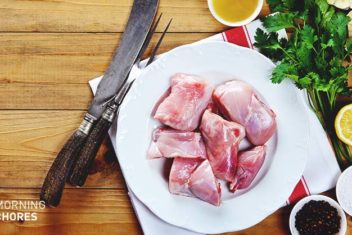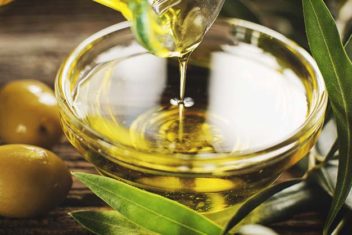If you are looking to raise a reliable meat source, then look no further than rabbits.
They may seem small, but because they reproduce so quickly one rabbit can give anywhere from 125-250 pounds of meat per year (depending on how frequently the doe is bred and how many kits per litter.)
There is much to learn about raising rabbits for meat, but they are a perfect fit for any size homestead.
What You’ll Learn in this Guide:
- Choosing Meat Rabbit Breeds
- Building the Shelter
- Feeding Your Rabbits
- Rabbit Waterers
- What You Shouldn’t Do
- Basic Health Needs
- Proper Bedding for Rabbits
- Mating Process
- Signs of Birth
- Behavior After Giving Birth
Choosing Meat Rabbit Breeds
Not all rabbits are created equal. Some breeds are much larger than others.
For beginners, I highly recommend raising New Zealand rabbits. They are big, white rabbits that grow to be the size of a large cat.
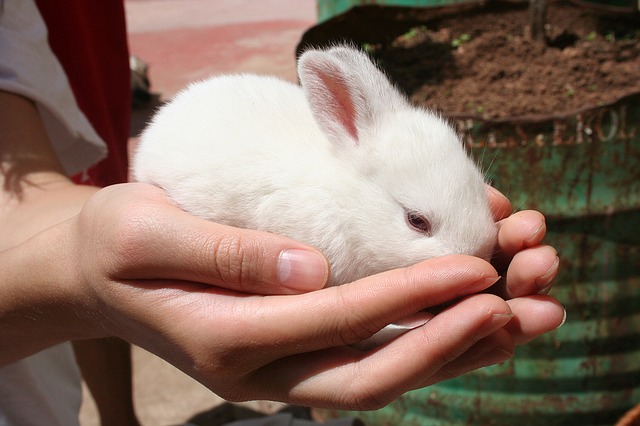
Here’s a list of the best rabbit breeds for meat:
| Breed Name | Weight (lbs) | Note |
|---|---|---|
| New Zealand | 10-12 | Most common breed for meat Excellent meat production |
| American | 9-12 | Good mothering traits |
| Californian | 10-12 | Good meat to bone ratio |
| Florida White | 4-6 | Good feed to meat ratio Good meat to bone ratio |
| American Chinchilla | 9-12 | Good breeders |
| Silver Fox | 9-12 | Rare Breed Good meat to bone ratio |
| Standard Rex | 7.5-10.5 | Most common breed for fur |
| Palomino | 8-12 | Fast growth |
| Champagne D’ Argent | 8 | High pelt value |
| Satin | 9-11 | High pelt and fur value |
| Beveren | 9-12 | Fast growth |
| Cinnamon | 8.5-11 | Good meat to bone ratio Relatively new breed |
It is important to know that when raising rabbits for meat that the older the rabbit gets, the tougher the meat becomes. The perfect butchering age is around 8 weeks of age. This means you will need a larger breed so it will be a decent size by the 8-week mark.
Building the Shelter
Rabbits require a hutch for shelter.
A rabbit hutch is basically a wooden box divided into two sections. One section has wire mesh on all sides, and the other section is closed in with wooden sides with only the bottom being mesh wire.
Wire mesh is an essential component of the shelter because it is small enough that the rabbits can stand on without falling through. However, it makes for easier cleaning of the hutch because most of the rabbit’s waste will fall through.
Another important part of keeping rabbits in hutches is to be sure they have a piece of wood to gnaw on. This not only keeps their teeth filed down but also gives their feet a break from standing on the wire all of the time.
This piece of wood can be as simple as a small, round twig.
Watch this video to learn how to build a rabbit hutch:
Or read this collection of 50 DIY rabbit hutch plans.
If you choose not to use a hutch for your rabbit, there is a colony option.
This is a more difficult way for breeding purposes because all of the rabbits stay together at all times. If you choose a colony setting, then you just need to fence in a grassy area. The rabbits will dig their own holes for shelter.
Read this article to learn more about raising rabbits in a colony.
If you wish to build your rabbits a shelter in a colony setting, you basically just put a roof on short stilts so the rabbits have just enough room to get under it. This will provide coverage from the weather but don’t be surprised if they still dig their own holes.
Rabbits are extremely hot-natured so it is important to place their shelter in a shaded area. In the summer, it is wise to place frozen water bottles in the hutches with the rabbits to help keep them cool.
Feeding Your Rabbits
When raising rabbits for meat there are many options for food.
You can purchase rabbit pellets from a feed store. These pellets are filled with protein and will help add the necessary weight to your rabbits in a short amount of time.
If you choose to buy commercial dry food, here’s a good article that compares the nutrition for every dry food brand.
Fodder, hay, and vegetables are more natural feed options if you prefer organic meat. Fodder is sprouted wheatgrass. It is extremely inexpensive to raise and provides all of the nutrients your rabbits will need.
Learn more about growing fodder which can provide the nutrients needed, affordably.
Hay is another inexpensive feed option. It can be purchased from local agricultural stores. Rabbits truly only require a ball of hay the size of themselves to meet their daily nutritional needs.
Vegetables are favorites for rabbits. If you grow a garden and have leftovers your rabbits will devour them! They love carrots, lettuce, tomatoes, weeds, etc.
Any vegetation you have, they will eat! This is another great reason for raising meat rabbits.
To make sure you’re feeding your rabbits right, here are the nutritional needs for a rabbit according to National Research Council 1194 about Nutrient Requirement of Rabbits:
| Class of Production | % Protein | % Fat | Calories (per lb.) | % Fiber | Daily Feeding Level |
|---|---|---|---|---|---|
| Pregnant (21d.) or Lactating | 16-20 | 3-5.5 | 1136 | 12-14 | Free choice |
| Growing Fryer (1-3 mo.) | 16 | 2-4 | 1136 | 14-16 | Free Choice |
| Replacement (3-5 mo.) | 16 | 2-4 | 1136 | 14-16 | 6-8 oz. |
| Breeding Bucks | 16 | 2-3 | 1136 | 14-20 | 6-8 oz. |
| Dry Bucks/Does | 12-15 | 2-3.5 | 955 | 14-20 | 4-6 oz. |
As you can tell the cost of feeding them is very little, if any. Also, you only feed additional rabbits beyond your breeding set for 8 weeks. Therefore, you not only get a lot of meat but organic meat for next to no cost.
Rabbit Waterers
You can use small bowls for rabbit waterers or purchase rabbit waterers from local pet stores.
Rabbits drink quite a bit of water so what we have adapted for our meat rabbits is a little different. We pay $5 for the nozzles that go on the basic rabbit waterers. Then we save 2-liter bottles and place the nozzles on them.
These modified waterers are then zip-tied to the rabbit hutches. This ensures that the rabbits have plenty of water, and we only have to refill them a few times a week instead of multiple times a day.
The Basic No-no’s to Keeping Meat Rabbits
Rabbits require bedding in the rabbit hole sections of their hutches. This is where rabbits will sleep and have their babies.
Do not use straw in these sections.
Straw is a carrier of mites. Rabbits are very susceptible to ear mites. Therefore, avoiding straw should help avoid ear mites.
It is okay to use wood shavings in their bedding if they do not have babies in the hutch with them. The wood shavings carry a scent that can damage the kits’ (baby rabbits’) respiratory systems and potentially cause death.
You must keep flies away from the rabbit hutches.
Flies will embed themselves in the baby rabbits and feast on them. This will kill your kits. You can keep flies away with fly-away strips posted on the hutches or wipe everything down with vinegar.
Basic Health Needs Of Rabbits
Rabbits require very little maintenance.
1. Ear Mites
The most important thing you can do to ensure you raise healthy rabbits is to prevent ear mites and keep their living quarters clean.
The best way to prevent ear mites is to place a few drops of oil (olive, vegetable, etc.) mixed with tea tree oil in each of your rabbit’s ears. You will know your rabbit has ear mites when you notice their ears become waxy and have a lot of scabs.
If your rabbits get ear mites, one way to treat their ears is with 2-3 drops of oil in the infected ear every other day for 30 days. Then clean their hutches out with a diluted bleach mixture to ensure all mites are exterminated.
2. Hygiene
Secondly, you must clean your rabbits’ hutches weekly.
Be sure to spray down the hutches with a diluted bleach mixture. When cleaning the hutches be sure to remove your rabbits and give the hutches time to air out before placing them in the hutches again. You can achieve this by setting up a puppy play pin and letting them spend the day hopping around in it.
You also need to scrape out any leftover animal waste, replace old bedding with a fresh one, and check their waterers to make sure they are clean and working properly.
Raising a reliable meat source starts with good health for the animals.
Proper Bedding for Rabbits
The easiest bedding for your rabbits is paper. Old, shredded paper.
When you go through your filing cabinet, receive junk mail, or when you toss the morning paper don’t discard that waste, invest in a shredder, and shred it! Then fill your rabbits’ rabbit holes with shredded paper.
This is safe for both the mothers and the babies.
However, paper or newspaper is not the best material because your rabbits will play with it and the ink will cover their fur. Shredded cardboard is a better option.
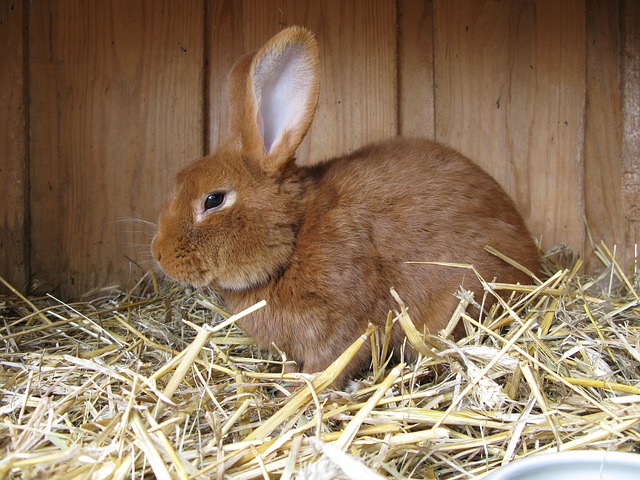
Wood shavings are okay for the mothers by themselves or while they are pregnant and for the bucks (male rabbits). However, wood shavings are unsafe for baby rabbits.
The best material for bedding is hay. Hay can be used as food, but it also makes good bedding for rabbits to keep them warm.
The Mating Process
There are tricks for successfully mating your rabbits.
It is recommended to keep your rabbits in hutches because rabbits prefer to be in smaller spaces for safety purposes. It also makes keeping track of birthing dates much easier.
You need to keep your males and females separated all the time, except when mating. Take the female to the male’s hutch, this will make her less territorial and more open to being courted.
You will know your female has been bred when you see what is called a “fall off.” This is when you see the male rabbit literally fall off of the female. He will become very stiff and fall over as if he were dead.
But don’t worry, he will regain his composure after a brief rest.
Signs of Birth
If you are raising meat rabbits, learning about rabbits’ birthing habits is one of the most important aspects.
A rabbit’s gestation period is only 30 days.
This means you can have a new litter of baby bunnies in a month’s time. It will usually take a rabbit 1-2 pregnancies to figure out how to keep her babies alive.
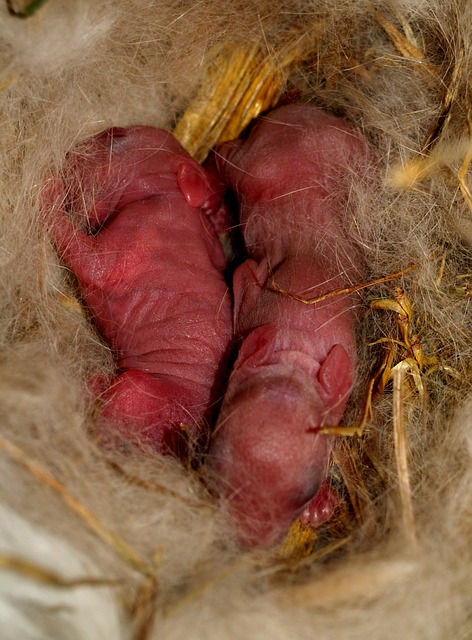
Don’t get too disappointed if the first litter does not survive. It happens, and it is all part of your mama bunny figuring out what to do.
She will get it figured out with time.
You will know your bunny is close to giving birth when she starts pulling her own hair out. She will pull her underside almost bald when her babies are close to arriving.
She’s doing this for extra bedding in her rabbit hole, to ensure her babies are warm.
Mama Bunny’s Behavior After Giving Birth
So your rabbit had babies, now what?
First of all, don’t go loving all over the babies.
This will upset your mama rabbit and might discourage her from caring for her kits. You can hover your hand over them in the rabbit fur to be sure they are alive but do not take them away from the rabbit hole.
Do not panic if you never catch the mama bunny feeding her babies.
It is a rabbit’s instinct to hide where her babies are. She will most likely never go near them during the day or with an audience. She will feed her babies around twice a day and both when she thinks no one is watching.
Once the babies gain their fur and are off and hopping, their mama will lighten up a little bit. They will start coming out of the rabbit hole.
She will wean them when they are ready. The only thing you will need to do is possibly prepare a different hutch or pin to move them to when they become too large to stay with their mother anymore.
That’s everything you need to know about raising rabbits for meat.
Raising rabbits for meat is an amazing process. Do you think you would like to raise the world’s cutest meat source?

